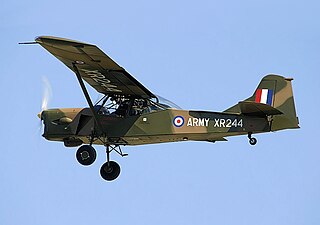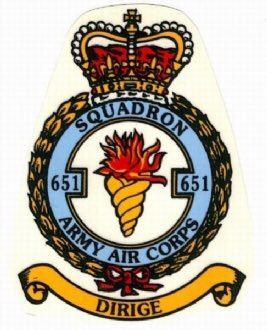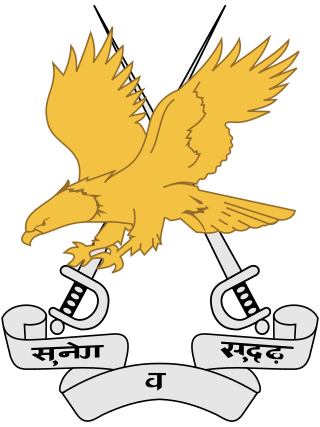
The Army Air Corps (AAC) is a component of the British Army, first formed in 1942 during the Second World War by grouping the various airborne units of the British Army. Today, there are eight regiments of the AAC as well as two Independent Flights and two Independent Squadrons deployed in support of British Army operations around the world. Regiments and flights are located in the United Kingdom, Kenya, and Canada. Some AAC squadrons provide the air assault elements of 16 Air Assault Brigade through Joint Helicopter Command.

The Westland Lysander is a British army co-operation and liaison aircraft produced by Westland Aircraft that was used immediately before and during the Second World War.

An artillery observer,artillery spotter, or forward observer (FO) is a soldier responsible for directing artillery and mortar fire support onto a target. An artillery observer usually accompanies a tank or infantry unit. Spotters ensure that indirect fire hits targets which those at a fire support base cannot see.

RAF Andover is a former Royal Flying Corps and Royal Air Force station in England, 2 miles (3.2 km) west of Andover, Hampshire. As well as RFC and RAF units, units of the Aviation Section, U.S. Signal Corps, Royal Canadian Air Force, United States Army Air Forces, and the Air Transport Auxiliary were also stationed at the airfield.

No. 16 Air Observation Post Flight was a Royal Australian Air Force (RAAF) unit that saw action in World War II supporting Australian Army operations. It was formed in October 1944 and disbanded in June 1947. The flight was reestablished in September 1958, and was disbanded again in December 1960, when its responsibilities were transferred to a joint Army-RAAF unit.

Old Sarum Airfield is a grass strip airfield 2 nautical miles north-north-east of Salisbury, Wiltshire, England.
No. 666 Squadron was a Royal Air Force Air Observation Post (AOP) squadron associated with the Canadian 1st Army and later part of the Royal Auxiliary Air Force. Numbers 651 to 663 Squadron of the RAF were Air Observation Post units working closely with British Army units in artillery spotting and liaison. A further three of these squadrons, 664–666, were manned with Canadian personnel. Their duties and squadron numbers were transferred to the Army with the formation of the Army Air Corps on 1 September 1957

The Taylorcraft Auster was a British military liaison and observation aircraft produced by the Taylorcraft Aeroplanes (England) Limited company during the Second World War.

No. 17 Air Observation Post Flight was a Royal Australian Air Force artillery-spotting and liaison unit which saw action as part of the Bougainville campaign and New Britain campaign in World War II. The flight was established in October 1944 and disbanded in December the next year.

The Auster AOP.9 was a British military air observation aircraft produced by Auster Aircraft Limited to replace the Auster AOP.6.
No. 652 Squadron RAF was a unit of the Royal Air Force during the Second World War and afterwards in Germany. Numbers 651 to 663 Squadrons of the RAF were Air Observation Post units working closely with Army units in artillery spotting and liaison. A further three of these squadrons, 664, 665 and 666, were AOP units of the Royal Canadian Air Force manned by Canadian and British personnel. Their duties and squadron numbers were transferred to the Army with the formation of the Army Air Corps on 1 September 1957.
No. 663 Squadron was an Air Observation Post (AOP) unit, manned with Polish Army personnel, which was officially formed in Italy on 14 August 1944. Numbers 651 to 663 Squadrons were Air Observation Post units working closely with Army units in artillery spotting and liaison. A further three of these squadrons, 664–666, were manned with Canadian personnel. Their duties and squadron numbers were transferred to the Army with the formation of the Army Air Corps on 1 September 1957.
No. 666 Squadron RCAF was originally an RCAF Air Observation Post (AOP) squadron formed during the Second World War. It was manned principally by Royal Canadian Artillery (RCA) and Royal Canadian Air Force (RCAF) personnel.
No. 661 Squadron was a Royal Air Force Air Observation Post squadron associated with the Canadian 1st Army and later part of the Royal Auxiliary Air Force. Numbers 651 to 663 Squadrons of the RAF were Air Observation Post units working closely with Army units in artillery spotting and liaison. A further three of these squadrons, 664–666, were manned with Canadian personnel. Their duties and squadron numbers were transferred to the Army with the formation of the Army Air Corps on 1 September 1957.

No. 662 Squadron was a Royal Air Force Air Observation Post squadron associated with the 21st Army Group and later part of the Royal Auxiliary Air Force. Numbers 651 to 663 Squadrons of the RAF were Air Observation Post units working closely with Army units in artillery spotting and liaison. A further three of these squadrons, 664–666, were manned with Canadian personnel. Their duties and squadron numbers were transferred to the Army with the formation of the Army Air Corps on 1 September 1957. It is now an Apache Helicopter Squadron.
No. 665 "Air Observation Post" Squadron, RCAF was formed in England during the Second World War. It was manned principally by Royal Canadian Artillery (RCA) and Royal Canadian Air Force (RCAF) personnel, with select British artillery pilots briefly seconded to assist in squadron formation. Numbers 651 to 663 Squadrons of the RAF were Air Observation Post units working closely with Army units in artillery spotting and liaison. A further three of these squadrons – Nos. 664, 665 and 666 – were RCAF AOP squadrons manned by Canadian and British personnel.

No. 651 Squadron Army Air Corps, is an aircraft squadron of the British Army, originally formed as No. 651 Squadron Royal Air Force in Italy and North Africa during the Second World War, and afterwards in Egypt. Numbers 651 to 663 Squadrons of the RAF were Air Observation Post units which had both Army and RAF personnel. The pilots, drivers and signallers were in the Royal Artillery whilst the adjutants, technical staff and equipment officers came from the RAF. Air observation posts were used primarily for artillery spotting, but occasionally for liaison and other duties. Their duties and squadron numbers were transferred to the Army with the formation of the Army Air Corps on 1 September 1957.

The Army Aviation Corps (AAC) is the youngest arm of the Indian Army, being formally designated on 1 November 1986. The Army Aviation Corps units are designated as Squadrons. Each squadron generally consists of two Flights. Reconnaissance (Recce) and Observation flights might be part of squadrons or operate independently. The latter do not have a parent squadron and are designated by an (I) in their name.
No. 664 Squadron was a Royal Air Force Air Observation Post squadron associated with the Canadian 1st Army and later part of the Royal Auxiliary Air Force. Numbers 651 to 663 Squadrons of the RAF were Air Observation Post units working closely with Army units in artillery spotting and liaison. A further three of these squadrons, 664–666, were manned with Canadian personnel. Their duties and squadron numbers were transferred to the Army with the formation of the Army Air Corps on 1 September 1957.
No. 656 Squadron RAF was an Air Observation Post unit of the Royal Air Force in India and Burma during the Second World War and afterwards in British Malaya. Numbers 651 to 663 Squadron of the RAF were Air Observation Post units working closely with British Army units in artillery spotting and liaison. Their duties and squadron numbers were transferred to the Army with the formation of the Army Air Corps on 1 September 1957 With this it became 656 Light Aircraft Squadron Army Air Corps.














